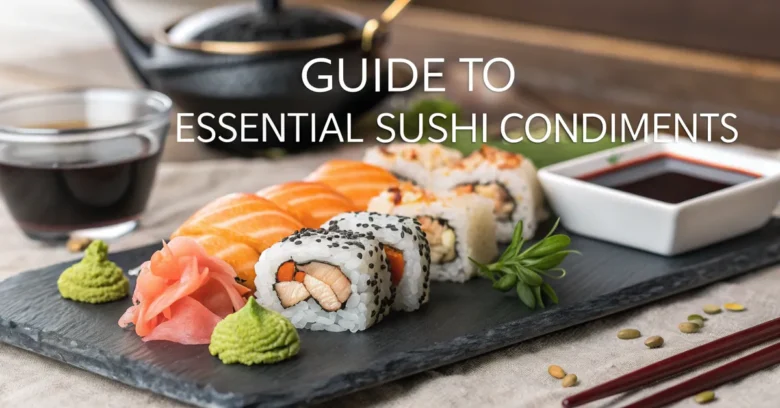Craving sushi at home? Then you know the rice, the fish, and the rolling are just the start. But a true sushi experience isn’t complete without the right sushi condiments. These flavor boosters can lift your homemade creations from good to great.
This guide dives deep into the world of sushi condiments. We’ll cover the essentials every home cook should know about, so you can build your own flavor arsenal and enjoy sushi night to the fullest. You’ll discover how to use each condiment to its full potential, ensuring every bite is an explosion of taste.
Understanding Sushi Condiments
Sushi is a dish built on balance. The creamy texture of fish, the subtle sweetness of rice, and the crispness of seaweed all play their roles. Sushi condiments are the final piece of the puzzle, adding sparks of acidity, saltiness, spice, and umami that elevate the entire experience. They aren’t just afterthoughts; they are integral to the art of sushi.
The Core Four: Essential Sushi Condiments
Every home sushi chef should have these four staples on hand:
Soy Sauce: The Salty Foundation
Soy sauce is perhaps the most recognizable sushi condiment. This fermented sauce, made from soybeans, wheat, salt, and a fermenting agent, is a fundamental element in Japanese cuisine. It brings a savory, salty depth to the often-delicate flavors of sushi.
-
Types of Soy Sauce:
- Koikuchi Shoyu (Dark Soy Sauce): The most common type in Japan. It is all-purpose with a balanced flavor.
- Usukuchi Shoyu (Light Soy Sauce): Saltier and lighter in color than Koikuchi. It is often used in cooking to add salt without darkening the dish.
- Tamari: Traditionally made without wheat, making it a gluten-free option. It has a richer, more complex flavor than some other soy sauces.
- Saishikomi Shoyu (Twice-Brewed Soy Sauce): Made by using Koikuchi soy sauce instead of brine in the brewing process. It is darker, richer, and less salty.
- Choosing the Right Soy Sauce for Sushi: For sushi, Koikuchi shoyu is generally the best all-around choice. Tamari is a good option for those avoiding gluten.
- How to Use Soy Sauce Properly: The key is restraint. Don’t drown your sushi! A light dip of the fish side only is ideal. Too much soy sauce overpowers the delicate flavors. It is best not to pour soy sauce all over the rice of the sushi. The rice has already been flavored and it will not taste as it’s supposed to.
- Sodium Content Awareness: Soy sauce is high in sodium. Be mindful of portion sizes, especially if you are watching your sodium intake. There are low-sodium options available if needed.
Wasabi: The Fiery Kick
Wasabi is the green paste served alongside sushi, bringing a sharp, pungent heat. Real wasabi is made from the grated stem of the Wasabia japonica plant. However, due to its high cost and limited availability, most wasabi served outside of Japan is a mixture of horseradish, mustard, and green food coloring.
- Real Wasabi vs. Imitation Wasabi: Real wasabi has a complex, nuanced flavor with a clean, refreshing heat that fades quickly. Imitation wasabi is much more intense, often with a lingering, artificial burn.
- How to Use Wasabi Correctly: The goal is to enhance, not overwhelm. A tiny dab of wasabi on the fish, before dipping in soy sauce, is the traditional method. This allows the wasabi to meld with the fish and soy sauce flavors.
- Mixing Wasabi into Soy Sauce (Is it Okay?): While it’s often seen, mixing wasabi directly into soy sauce isn’t considered proper etiquette. Purists believe it muddies the flavors. However, in the end, enjoying sushi is about personal preference.
- Storing Wasabi: Fresh wasabi root should be stored in the refrigerator, wrapped in a damp cloth. Wasabi paste should be kept tightly sealed to prevent it from drying out.
Gari (Pickled Ginger): The Palate Cleanser
Gari, or pickled ginger, is the thinly sliced, sweet, and tangy ginger served alongside sushi. Its purpose is to cleanse the palate between different pieces of sushi, allowing you to fully appreciate each distinct flavor.
- Why Ginger is Pink: Young ginger naturally has a pinkish hue. Some gari is also dyed pink for aesthetic reasons.
- How to Eat Gari: Take a slice or two of gari between pieces of sushi. It is not meant to be eaten on top of the sushi.
- Making Gari at Home: Gari is surprisingly easy to make at home! It requires fresh ginger, rice vinegar, sugar, and salt. Many recipes can easily be found online.
- Benefits of Eating Ginger: Ginger has anti-inflammatory and digestive properties. It can help soothe the stomach and aid in digestion.
Rice Vinegar: The Foundation of Sushi Rice
While not technically a sushi condiment served on the side, rice vinegar is essential for making perfect sushi rice. This mild vinegar, made from fermented rice, gives sushi rice its characteristic tang and helps it bind together.
-
Types of Rice Vinegar:
- White Rice Vinegar: The most common type. It is clear, mild, and slightly sweet.
- Black Rice Vinegar: Richer and more complex in flavor than white rice vinegar.
- Seasoned Rice Vinegar: Rice vinegar with added sugar and salt, ready to be used in sushi rice.
- Making Sushi Rice: The key to great sushi is the rice. Cook short-grain Japanese rice according to package directions. While still warm, gently mix in a solution of rice vinegar, sugar, and salt. Allow the rice to cool completely before using.
- Adjusting Sweetness and Acidity: The ratio of rice vinegar, sugar, and salt can be adjusted to suit your taste. Start with a basic recipe and adjust from there.
Beyond the Basics: Exploring Other Sushi Condiments
Once you have mastered the core four, there’s a whole world of other sushi condiments to explore:
Spicy Mayo: The Creamy Kick
Spicy mayo adds a creamy, spicy element to sushi. It’s typically made from mayonnaise, sriracha (or other chili sauce), and sometimes a touch of rice vinegar or lemon juice.
- Making Spicy Mayo: Simply combine mayonnaise and sriracha to your desired level of spiciness. Adjust the flavor with rice vinegar or lemon juice.
- Popular Sushi Rolls with Spicy Mayo: Spicy tuna rolls, spicy salmon rolls, and California rolls often feature spicy mayo.
- Vegan Spicy Mayo: Use vegan mayonnaise to create a plant-based version.
Eel Sauce (Unagi Sauce): The Sweet Glaze
Eel sauce, also known as unagi sauce, is a thick, sweet, and savory sauce made from soy sauce, mirin (sweet rice wine), sugar, and sake. It is traditionally used to glaze grilled eel (unagi), but it’s also delicious on other types of sushi.
- What Makes it Unique: The combination of sweet and savory flavors is what sets eel sauce apart.
- Using Eel Sauce: Drizzle eel sauce sparingly over sushi rolls or nigiri.
- Vegan Eel Sauce: Some vegan recipes use a combination of soy sauce, maple syrup, rice vinegar, and seaweed to mimic the flavor of eel sauce.
Ponzu Sauce: The Citrusy Zing
Ponzu sauce is a citrus-based sauce made from soy sauce, rice vinegar, mirin, bonito flakes (dried fish flakes), and citrus juice (usually yuzu, lemon, or lime). It offers a bright, tangy flavor that complements many types of sushi.
- Flavor Profile: Ponzu is lighter and more acidic than soy sauce.
- Using Ponzu: Use ponzu as a dipping sauce instead of soy sauce for a lighter flavor.
- Homemade Ponzu: Ponzu can be made at home, although it requires some specialized ingredients like yuzu juice and bonito flakes.
Sesame Seeds: The Nutty Crunch
Sesame seeds, both white and black, add a subtle nutty flavor and a pleasant crunch to sushi. They are often sprinkled on top of sushi rolls or nigiri.
- Black vs. White Sesame Seeds: Black sesame seeds have a slightly more intense flavor than white sesame seeds.
- Toasting Sesame Seeds: Toasting sesame seeds before using them enhances their nutty flavor.
- Gomashio: Sesame Salt: Gomashio is a Japanese condiment made from toasted sesame seeds and salt. It adds a salty, nutty flavor to sushi rice.
Chili Oil: The Bold Heat
For those who crave serious spice, chili oil can be a fantastic addition to sushi night. Look for Japanese chili oil, which often contains crispy garlic and other flavorful ingredients.
- Japanese Chili Oil (Rayu): Rayu is a Japanese chili oil that typically contains sesame oil, chili peppers, and other aromatics.
- How to Use Chili Oil: Drizzle a small amount of chili oil over sushi rolls or nigiri for a spicy kick.
- Controlling the Spice Level: Start with a tiny amount and add more to your liking.
Tobiko and Masago: The Popping Texture
Tobiko and masago are types of fish roe (eggs) that add a salty, slightly crunchy texture to sushi. Tobiko is the roe of the flying fish, while masago is the roe of the capelin.
- Tobiko vs. Masago: Tobiko is larger and more flavorful than masago. It is also more expensive.
- Colors of Tobiko: Tobiko can be naturally orange, but it is often dyed red, green, or black.
- Using Tobiko and Masago: Sprinkle tobiko or masago on top of sushi rolls or use them as a garnish.
Daikon Radish: The Crisp Refreshment
Thinly shredded daikon radish can be served alongside sushi as a refreshing palate cleanser. It has a mild, slightly peppery flavor.
- Preparing Daikon Radish: Use a mandoline or sharp knife to thinly shred the daikon radish.
- Marinating Daikon: Marinating the daikon in a sweet vinegar solution can enhance its flavor.
Tips for Choosing and Storing Sushi Condiments
- Read Labels Carefully: Check the ingredient lists for unwanted additives, preservatives, or high sodium content.
- Buy Smaller Quantities: Unless you use them frequently, buy smaller quantities of condiments to ensure freshness.
- Store Properly: Store condiments in airtight containers in a cool, dark place or in the refrigerator, as directed on the label.
- Check Expiration Dates: Pay attention to expiration dates and discard any condiments that have expired.
Building Your Sushi Condiment Arsenal
Start with the core four: soy sauce, wasabi, gari, and rice vinegar. Then, experiment with other sushi condiments to find your favorites. Consider your spice tolerance, flavor preferences, and the types of sushi you enjoy most. A well-stocked condiment arsenal will allow you to create a truly personalized sushi experience at home.
Common Mistakes to Avoid with Sushi Condiments
- Over-Saucing: Less is more! Don’t drown your sushi in soy sauce or other condiments.
- Mixing Wasabi Incorrectly: Avoid stirring wasabi directly into your soy sauce, unless you truly enjoy it that way.
- Neglecting Gari: Don’t forget to use the gari to cleanse your palate between different pieces of sushi.
- Ignoring Quality: Choose high-quality condiments for the best flavor and experience.
Delicious Combinations
The best sushi condiments are the ones you enjoy. It is key to experiment with different flavors until you find your favorite combinations. The options are limitless!
Elevate Your Sushi Experience With the Right Condiments
With the right sushi condiments, you can transform your homemade sushi from simple to sensational. From the salty depth of soy sauce to the fiery kick of wasabi and the refreshing tang of gari, each condiment plays a vital role in creating a balanced and flavorful sushi experience. So, experiment, explore, and discover your favorite flavor combinations. Soon, you will create sushi at home with confidence.



